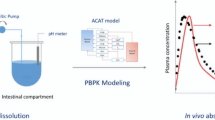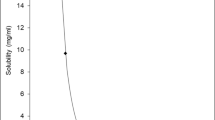Abstract
Physiologically based absorption modeling has been attracting increased attention to study the interactions of weakly basic drug compounds with acid-reducing agents like proton-pump inhibitors and H2 blockers. Recently, standardized gastric and intestinal biorelevant media to simulate the achlorhydric and hypochlorhydric stomach were proposed and solubility and dissolution data for two model compounds were generated. In the current manuscript, for the first time, we report the utility of these recently proposed biorelevant media as input into physiologically based absorption modeling. Where needed, data collected with the biorelevant gastrointestinal transfer (BioGIT) system were used for informing the simulations in regard to the precipitation kinetics. Using two model compounds, a HCl salt and a semi-fumarate co-crystal which as expected dissolve to a greater extent in these media (and in gastric and intestinal human aspirates) compared to what the pH–solubility profile of the free form would suggest, we demonstrate successful description of the plasma concentration profiles and correctly predicted the lack of significant interaction after administration with pantoprazole or famotidine, respectively. Thus, the data reported in this manuscript represent an initial step towards defining biorelevant input for such simulations on interactions with acid-reducing agents.




Similar content being viewed by others
References
Mitra A, Kesisoglou F, Beauchamp M, Zhu W, Chiti F, Wu Y. Using absorption simulation and gastric pH modulated dog model for formulation development to overcome achlorhydria effect. Mol Pharm. 2011;8(6):2216–23.
Bhattachar SN, Perkins EJ, Tan JS, Burns LJ. Effect of gastric pH on the pharmacokinetics of a BCS class II compound in dogs: utilization of an artificial stomach and duodenum dissolution model and GastroPlus™ simulations to predict absorption. J Pharm Sci. 2011;100(11):4756–65.
Chung J, Alvarez-Nunez F, Chow V, Daurio D, Davis J, Dodds M, et al. Utilizing physiologically based pharmacokinetic modeling to inform formulation and clinical development for a compound with pH-dependent solubility. J Pharm Sci. 2015;104(4):1522–32. https://doi.org/10.1002/jps.24339.
Parrott NJ, Yu LJ, Takano R, Nakamura M, Morcos PN. Physiologically based absorption modeling to explore the impact of food and gastric pH changes on the pharmacokinetics of alectinib. AAPS J. 2016;18(6):1464–74.
FARYDAK®. Clinical pharmacology and biopharmaceutics review(s). https://www.accessdata.fda.gov/drugsatfda_docs/nda/2015/205353Orig1s000ClinPharmR.pdf. Accessed on 06 Dec 2017.
Cristofoletti R, Patel N, Dressman JB. Assessment of bioequivalence of weak base formulations under various dosing conditions using physiologically based pharmacokinetic simulations in virtual populations. Case examples: ketoconazole and posaconazole. J Pharm Sci. 2017;106(2):560–9.
Lu T, Fraczkiewicz G, Salphati L, Budha N, Dalziel G, Smelick GS, et al. Combining “bottom-up” and “top-down” approaches to assess the impact of food and gastric pH on pictilisib (GDC-0941) pharmacokinetics. CPT Pharmacometrics Syst Pharmacol. 2017;6:747–55. https://doi.org/10.1002/psp4.12228.
Seiler D, Doser K, Salem I. Relative bioavailability of prasugrel free base in comparison to prasugrel hydrochloride in the presence and in the absence of a proton pump inhibitor. Arzneimittelforschung. 2011;61(4):247–51.
Doki K, Darwich AS, Patel N, Rostami-Hodjegan A. Virtual bioequivalence for achlorhydric subjects: the use of PBPK modelling to assess the formulation-dependent effect of achlorhydria. Eur J Pharm Sci. 2017;109:111–20.
Litou C, Vertzoni M, Xu W, Kesisoglou F, Reppas C. The impact of reduced gastric acid secretion on dissolution of salts of weak bases in the fasted upper gastrointestinal lumen: data in biorelevant media and in human aspirates. Eur J Pharm Biopharm. 2017;115:94–101. https://doi.org/10.1016/j.ejpb.2017.02.009.
Kourentas A, Vertzoni M, Stavrinoudakis N, Symillidis A, Brouwers J, Augustijns P, et al. An in vitro biorelevant gastrointestinal transfer (BioGIT) system for forecasting concentrations in the fasted upper small intestine: design, implementation, and evaluation. Eur J Pharm Sci. 2016;82:106–14. https://doi.org/10.1016/j.ejps.2015.11.012.
Markopoulos C, Andreas C, Vertzoni M, Dressman J, Reppas C. In-vitro simulation of luminal conditions for evaluation of performance of oral drug products: choosing the appropriate test media. Eur J Pharm Biopharm. 2015;93:173–82.
Kesisoglou F, Mitra A. Application of absorption modeling in rational design of drug product under quality-by-design paradigm. AAPS J. 2015;17(5):1224–36. https://doi.org/10.1208/s12248-015-9781-1.
Tsume Y, Amidon GL, Takeuchi S. Dissolution effect of gastric and intestinal pH for a BCS class II drug, pioglitazone: new in vitro dissolution system to predict in vivo dissolution. J Bioequiv Availab. 2013;5(6):224–7.
Ding X, Gueorguieva I, Wesley JA, Burns LJ, Coutant CA. Assessment of in vivo clinical product performance of a weak basic drug by integration of in vitro dissolution tests and physiologically based absorption modeling. AAPS J. 2015;17(6):1395–406.
Litou C, Vertzoni M, Goumas C, Vasdekis V, Xu W, Kesisoglou F, et al. Characteristics of the human upper gastrointestinal contents in the fasted state under hypo- and a-chlorhydric gastric conditions under conditions of typical drug-drug interaction studies. Pharm Res. 2016;33(6):1399–412.
Kostewicz ES, Aarons L, Bergstrand M, Bolger MB, Galetin A, Hatley O, et al. PBPK models for the prediction of in vivo performance of oral dosage forms. Eur J Pharm Sci. 2014;57:300–21. https://doi.org/10.1016/j.ejps.2013.09.008.
Acknowledgements
Authors would like to thank Ms. Chara Litou for her contribution to the BioGIT experiments. Part of the work presented in this manuscript was presented at the annual EDAN meeting, Leuven, Belgium, 11–13 March 2018.
Author information
Authors and Affiliations
Corresponding author
Additional information
Guest Editor: Sandra Klein
Rights and permissions
About this article
Cite this article
Kesisoglou, F., Vertzoni, M. & Reppas, C. Physiologically Based Absorption Modeling of Salts of Weak Bases Based on Data in Hypochlorhydric and Achlorhydric Biorelevant Media. AAPS PharmSciTech 19, 2851–2858 (2018). https://doi.org/10.1208/s12249-018-1059-3
Received:
Accepted:
Published:
Issue Date:
DOI: https://doi.org/10.1208/s12249-018-1059-3




